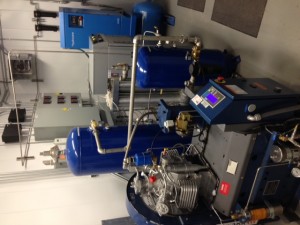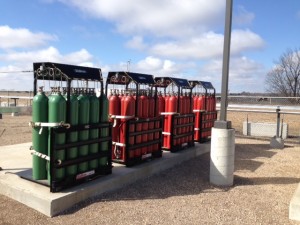 Did you know it’s possible to use wind energy to make fertilizer? And did you know that it’s being done right here in Minnesota, at the University of Minnesota’s West Central Research & Outreach Center (WCROC) in Morris?
Did you know it’s possible to use wind energy to make fertilizer? And did you know that it’s being done right here in Minnesota, at the University of Minnesota’s West Central Research & Outreach Center (WCROC) in Morris?
I didn’t know any of this, but was curious to learn more, so I visited the WCROC to a get a firsthand look at this innovative project. Mike Reese, WCROC’s director of renewable energy, was kind enough to spend a couple hours with me and walk me through the entire wind-to-fertilizer process.
Of course, I had to ask the obvious question right away: How in the heck did someone come up with the idea of turning wind power into fertilizer?
“It seemed like an elegant idea,” Reese said. “A farmer with a wind turbine could produce his own fertilizer. Or even do it on a larger scale. We thought it was a good way to help reduce farming’s carbon footprint and make use of the local renewable resources.”
Discussions about the project began in 2001 and a wind turbine was installed in 2005. The pilot production plant, which consists of a couple sheds that house the equipment and several storage tanks near the wind turbine, produced its first batch of anhydrous ammonia, which is used to make nitrogen fertilizer used to help grow corn, in January of 2013.
Wind power has many benefits. But it also presents challenges, mainly transmission capacity and inconsistent production when Mother Nature decides to make the wind stop blowing. Those challenges spurred Reese and the team at WCROC to look for ways to store wind energy and add value to it.
How it works
When Reese opened a door to one of the small buildings at the pilot plant, I saw a tanglement of pipes, hoses, valves and other things I would probably break if I started messing with them. I immediately thought to myself, “Everyone is going to ask me how this process works. And I won’t have any idea.”
 Sure enough, back at the office the next day, a colleague asked how the process worked. I tried to repeat what Reese explained to me, but probably got at least 17 things wrong.
Sure enough, back at the office the next day, a colleague asked how the process worked. I tried to repeat what Reese explained to me, but probably got at least 17 things wrong.
I’ve done some more homework since then, though. If you gave me a very basic test about the wind-to-fertilizer process, I could probably at least get a passing grade. Here is my condensed explanation. If you want more detail, go here.
- Wind, air and water are used to create nitrogen and hydrogen
- Power generated from a wind turbine breaks down water, which is made up of hydrogen and oxygen, and captures the naturally-occurring nitrogen in the atmosphere
- The gasses are compressed and stored in banks of cylinders
- The gasses are then combined using a catalyst in a 25-gallon chemical reactor to form anhydrous ammonia.
Another neat thing about the process, Reese explained, is how the extra heat created when the nitrogen and hydrogen form anhydrous ammonia is pumped back through a heat exchanger to help heat the incoming nitrogen and hydrogen.
Confused? Don’t worry about it. Just know that this innovative process is happening right here in Minnesota, and the people behind it have a vision to grow this project even further.
Commercial scale
Because of some pesky issues with sealing around the valves, the plant is not yet operating continuously. The system operates at over 1500 psi and 800 degrees farenheit so it can be difficult to find o-rings and other seal materials that can stand up to those harsh conditions for extended time. The team at WCROC is the first in the world to create fertilizer from wind energy, so, of course, there are going to be bumps along the way.
As with any innovation, the process will improve and leaks will be patched through trial and error and an extensive research process.
Right now the pilot plant doesn’t produce enough anhydrous ammonia to be viable on the commercial fertilizer market. Most of the ammonia is sent to a couple of local co-ops. But the WCROC team is working to scale the project up.
“We’d like to be able to develop a system that farmers could use to produce enough fertilizer to supply an entire county and sell back any extra energy,” Reese said. “Once we’re able to operate more steadily, we’ll be able to establish baselines on our fertilizer output and energy input.”
It would take approximately 10,000 tons of fertilizer to supply farmers in an average Minnesota county for the year. That would require roughly 20-30 wind turbines depending on the size and wind resource. The team is also looking at incorporating other energy systems such as solar and biomass.
“There are a lot of directions we can go with this,” Joel Tallacksen, a biomass scientist at WCROC. “We’re always finding ways to make the process more efficient.”
Two novel technologies being developed in labs at the St. Paul and Minneapolis campus may help  to make the process more efficient and cost effective so cooperatives and farmers can compete with the mega-scale plants. Once the technologies are ready, they will be tested at the pilot plant at the WCROC.
to make the process more efficient and cost effective so cooperatives and farmers can compete with the mega-scale plants. Once the technologies are ready, they will be tested at the pilot plant at the WCROC.
Homegrown fertilizer
One of the reasons corn farmers support ethanol fuel is because it’s homegrown. Ethanol comes from a corn field in Minnesota, not a Middle Eastern country that harbors ill-will toward the United States, or the environmentally sensitive Alberta Tar Sands.
The wind-to-fertilizer project is another way corn farmers support a homegrown and renewable resource. Most ammonia manufacturing has moved overseas to areas where natural gas is cheap. Why not use an abundant but under-used resource – wind energy – to make fertilizer right in the farming communities where it’s used?
Using check-off dollars, Minnesota’s corn farmers are supporting the research aspect of the wind-to-fertilizer project. It’s one of several projects supported by corn farmers that address nitrogen and corn production.
There’s also a market-based reason for corn farmers to support this innovative project.
Just like in other sectors of the economy, demand from consumers is growing for products that are produced as sustainably as possible. By supporting the development of a system that reduces agriculture’s carbon footprint, corn farmers are being proactive in doing what’s right for the environment, and getting out in front of a changing marketplace.
“Right now, we’re not at a point where something like this can compete on the market, but if the market shifts, this project will help farmers be ready,” Reese said.
Interest in the project is all over the map – literally. Local farmers call daily for updates and the WCROC team has done collaborative research with scientists in Sweden. American Indian tribes have also inquired about the process.
The future
I might not have understood all the details of exactly how wind energy is turned into fertilizer, but I do know this: Reese and his team are breaking new ground with this project. And it’s good to see Minnesota’s corn farmers providing support in the early stages.
There was once a time where it would have seemed impossible to power our vehicles with a fuel made from corn. Now, all fuel is blended with at least 10 percent ethanol.
Making fertilizer for corn fields from wind energy might also sound like a longshot, but it’s happening. Could wind-to-fertilizer one day become as big a part of our lives as ethanol? You never know.
“If we can produce fertilizer in a renewable and cost effective way, we need to do it,” Reese said. “People want products with a lower carbon footprint and our local economies could use a boost as well.”
By Adam Czech, MCGA

